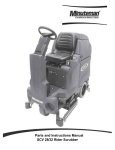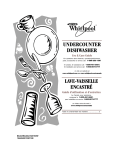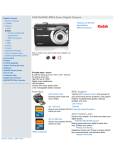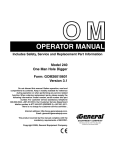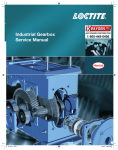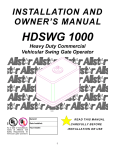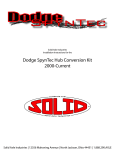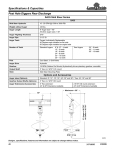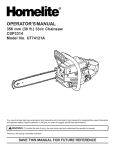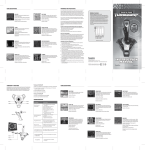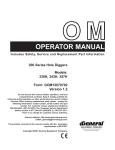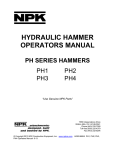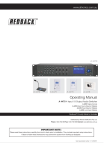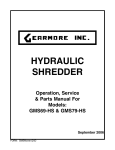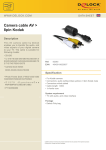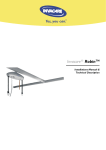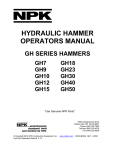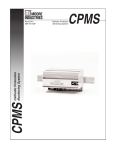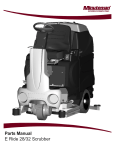Download (DIG-R-TACH) Operator Manual
Transcript
OPERATOR MANUAL Includes Safety, Service and Replacement Part Information Model 671 and 753 Series Hydraulic Hole Digger Form: GOM-1028-7-88 Version 1.0 Do not discard this manual. Before operation, read and comprehend its contents. Keep it readily available for reference during operation or when performing any service related function. When ordering replacement parts, please supply the following information: model number, serial number and part number. For customer service assistance, telephone 800.533.0524, +507.451.5510. Our Customer Service Department telefax number is 877.344.4375 (DIGGER 5), +507.451.5511. There is no charge for customer service activities . Internet address: http://www.generalequip.com. E-Mail location: [email protected]. Copyright 2003, General Equipment Company. Manufacturers of light construction equipment Congratulations on your decision to purchase a General light construction product. From our humble beginnings in 1955, it has been a continuing objective of General Equipment Company to manufacture equipment that delivers uncompromising value, service life and investment return. Because of this continuous commitment for excellence, many products bearing the General name actually set the standards by which competitive products are judged. When you purchased this product, you also gained access to a team of dedicated and knowledgeable support personnel that stand willing and ready to provide field support assistance. Our team of sales representatives and inhouse factory personnel are available to ensure that each General product delivers the intended performance, value and investment return. Our personnel can readily answer your concerns or questions regarding proper applications, service requirements and warranty related problems. General Equipment Company places great emphasis upon not only product performance, but also on product safety. It is important to remember that this product will only be as safe as the operators which utilize it. It just makes good, common sense to take the time to read and fully understand the contents of this manual before attempting to utilize this product in service. If you ever do have any questions or concerns about this product, please feel free to contact our Customer Service Department at the telephone numbers listed below for assistance. If there is anything that I can do to assist your efforts when utilizing this product, please do not hesitate to contact me. For assistance after normal business hours, telephone me at 507.451.9409 or 507.363.1033. If I am not immediately available, I will attempt to return your call as soon as possible. Sincerely, GENERAL EQUIPMENT COMPANY Dennis Von Ruden President 620 Alexander Drive SW • P.O. Box 334 • Owatonna, Minnesota 55060-0334 USA Telephone: 800.533.0524 • International Telephone: +507.451.5510 Telefax: +507.451.5511 • Sales/Customer Service Department Toll Free: 877.344.4375 (DIGGER 5) http://www.generalequip.com • e-mail: [email protected] Table of Contents DESCRIPTION PAGE Notice to Operators 3 Operator Instructional Data Sheet 5 Safety Precautoins 6 Operation MAINTENANCE, REPAIR AND STORAGE HYDRAULIC SYSTEM INFORMATION 7 8 9 Installation DIGGING OPERATION. AUGER EXTENSIONS. 12 14 16 Service CHAIN MAINTENANCE. BEARING MAINTENANCE. BEARING REPLACEMENT. 17 17 18 19 Trouble Shooting 20 Storage 20 Specificaiotns 20 Parts Breakdown 21 671 AND 753 HOLE DIGGERS, FORM GOM-1028-7-88, VERSION 1.0, AUTHORIZATION: DVR, PAGE: 2 Notice to Operators IF YOU CAN NOT READ OR DO NOT FULLY UNDERSTAND THE CONTENTS OF THIS MANUAL, PLEASE CONTACT THE FACTORY FOR PROPER ASSISTANCE BEFORE ATTEMPTING TO OPERATE THIS PRODUCT. SI TU NO PUEDES LE'ER O NO COMPRENDES EL CONTENIDO DE ESTE MANUAL FAVOR DE PONERSE EN CONTACTO CON LA. FABRICA PARA ASSISTENCIA- A PROPIA ANTES DE INTENTAR PARA OPERAR ESTE PRODUCTO. SOLLTEN SIE DIESE GEBRAUCHSANWEISUNG NICHT LESEN KOENNEN ODER ES NICHT VOLLKOMMEN VERSTEHEN, WENDEN SIE SICH BITTE AN DEN HERSTELLER FUER RICHTIGE HILFE EHE SIE VERSUCHEN DIESES PRODUKT ZU OPERIEREN. SI VOUS NE LISEZ OU NE COMPRENDRE ENTIEREMENT LES MATIERES DE CE MANUEL, S'IL VOUS PLAIT, CONTACTEZ L'USINE POUR L'ASSISTANCE APPROPRIEE AVANT D'UTILISER LE PRODUIT. These safety alert symbols identify important safety messages in this manual. When you see these symbols, be alert to the possibility of personal injury and carefully read the message that follows. Do not allow anyone to operate the Hole Digger without first reading this Operator's Manual and becoming familiar with its operation. The manufacturer of this Hole Digger has gone to great extremes to provide the owner(s) and/or operator(s) with the finest equipment available for its intended job function of digging holes in ice and earth formations. Yet, the possibility exists that the Hole Digger can be utilized in and/or subjected to job applications not perceived and/or anticipated by the manufacturer. Such misuse and/or misapplication of the Hole Digger can lead to the possibility of serious damage, injury or even death. It is the responsibility of the owner(s) and/or operator(s) to determine that the Hole Digger is being utilized and/or operated within the scope of its intended job function. It is the responsibility of the owner(s) and/or operator(s) to establish, monitor and constantly upgrade all safety programs and/or practices utilized in and for the operation of the Hole Digger. The purpose of such programs is to provide for owner(s') and/or operator(s') safety. Operators must be instructed to recognize and avoid unsafe conditions associated with their work (29 CFR 1926.21 (b)(2)) and/or applicable updated revisions. It is the responsibility of the owner(s) and/or operator(s) to determine that no modifications and/or alterations have been made to the Hole Digger. Modifications and/or alterations can lead to the possibility of serious damage, injury or even death. It is the responsibility of the owner(s) and/or operator(s) to make this Operator's Manual available for consultation during all phases of operation. Refer to OSHA 2207 which contains all OSHA job safety and health rules and regulations (1926 and 1910) covering construction. The concept of portable, one and two man operated, hole digging equipment has been successfully utilized for over forty years as a practical solution to many types of hole digging job requirements. The basic concept is proven and well accepted within the associated marketplaces as an alternative method to manual labor and/or larger, mounted earth drilling machinery. Use of a Hole Digger requires strenuous work activity. This type of work activity can be considered to be greater in magnitude than that experienced with the use of many other types of both light construction and lawn and garden related equipment. This type of work activity should only be attempted by operators of adequate physical size and stature, mental awarness and 671 AND 753 HOLE DIGGERS, FORM GOM-1028-7-88, VERSION 1.0, AUTHORIZATION: DVR, PAGE: 3 physical strength and condition. Each operator is required to supply a resultant force that counteracts/balances and/or resists the natural torque and kickback forces generated during the hole digging process. The body parts most noticably affected during the digging process are the arms, hands, wrists, shoulders, lower back and legs. The hole digging process can also produce excessive stress/strain directly to the back muscles, spinal vertabrae and many other body parts. Back related pain can be a side effect of the hole digging process. An operator with a chronic back related problem or a history of back and/or other medically related problems should not attempt to utilize the Hole Digger. Use of the Hole Digger may only aggrevate this and any other medically related problem. The torque and kickback forces generated and/or encountered correspond to the natural laws of physics and are inherent to the hole digging process. They can not be changed or totally eliminated with portable one and two man operated, hole digging equipment of this design. Proper operating positions and techniques, as outlined in this manual, can be successfully utilized to minimize the effects of the torque and kickback forces upon the human body. Because of the diverse type of prevailing digging conditions, operator experience levels and operator physical characteristics, no warranty, guarantee, representation and/or liability is made by the factory as to the absolute correctness or sufficiency of any operational procedure, operational position and/or technique. There is no absolute guarantee that an operator of any given experience level, physical size and/or physical condition will be immune to the possibility of and/or probable physical side effects of the normal hole digging process. The normal hole digging process includes the auger striking buried obstructions (roots, rocks, etc.) and the resulting torque and kickback forces created. Each potential operator of the Hole Digger must be made aware of and assume the operational and physical liability described and/or associated with the hole digging process when utilizing the Hole Digger. Each potential operator not willing to assume the operational and physical liability described and/or associated with the hole digging process should not operate the Hole Digger. Proper levels of operator experience, skill and common sense are essential for maximizing the safe and efficient operation of the Hole Digger. Record the Hole Digger and engine serial numbers in the spaces provided below. _______________ Model Number _______________ Serial Number _______________ Engine Serial Number _______________ Date of Purchase Specifications and design are subject to change without notice or obligation. All specifications are general in nature and are not intended for specific application purposes. General Equipment Company reserves the right to make changes in design, engineering or specifications and to add improvements or discontinue manufacture at any time without notice or obligation. General Equipment Company and its agents accept no responsibility for variations which may be evident in actual products, specifications, pictures and descriptions contained in this publication. Operator Instructional Data Sheet 671 AND 753 HOLE DIGGERS, FORM GOM-1028-7-88, VERSION 1.0, AUTHORIZATION: DVR, PAGE: 4 The following undersigned operators of the Hole Digger described and/or pertaining to this Operator's Manual have received formal safety and operational information/instruction from the undersigned owner(s)/instructor(s) in accordance to OSHA 29 CFR 1926.21 (b)(2) and/or applicable updated revisions pertaining to, but not necessarily limited to the: 1) READING, COMPREHENSION AND ACKNOWLEDGEMENT OF THE MATERIAL COMPRISING THE ENTIRE CONTENTS OF THE APPLICABLE OPERATOR'S MANUAL FOR THE HOLE DIGGER. 2) FORMALIZED OPERATOR'S SAFTEY PROGRAM TO BE DEVISED BY THE OWNER OF THE HOLE DIGGER IN CONJUNCTION WITH THE CONTENTS OF THE APPLICABLE OPERATOR'S MANUAL FOR THE HOLE DIGGER. 3) OSHA RULES AND REGULATIONS RESEARCHED FOR AND/OR BY THE OWNER OF THE HOLE DIGGER AND DEEMED APPLICABLE TO THE SAFE AND PROPER USE AND/OR OPERATION OF THE THE HOLE DIGGER FOR ANY SPECIFIC JOB APPLICATION. 4) LOCAL LAWS, REGULATIONS AND CUSTOMS RESEARCHED FOR AND/OR BY THE OWNER OF THE HOLE DIGGER AND DEEMED APPLICABLE TO THE SAFE AND PROPER USE AND/OR OPERATION OF THE HOLE DIGGER FOR ANY SPECIFIC JOB APPLICATION. 5) FORMALIZED MAINTENANCE PROGRAM FOR THE HOLE DIGGER TO BE DEVISED BY THE OWNER OF THE HOLE DIGGER IN ACCORDANCE WITH, BUT NOT NECESSARILY LIMITED TO, THE SPECIFICATIONS, GUIDELINES AND OPERATIONAL INFORMATION CONTAINED IN THE APPLICABLE OPERATOR'S MANUAL. 6) COMPREHENSIVE OPERATIONAL INSTRUCTIONS FOR THE CORRECT AND PROPER USE OF THE HOLE DIGGER AS PER THE CONTENTS OF THE APPLICABLE OPERATOR'S MANUAL. _______________ Operator _______________ Owner/Instructor __________ Date _______________ Operator _______________ Owner/Instructor __________ Date _______________ Operator _______________ Owner/Instructor __________ Date _______________ Operator _______________ Owner/Instructor __________ Date _______________ Operator _______________ Owner/Instructor __________ Date _______________ Operator _______________ Owner/Instructor __________ Date NOTE: INSERT COPIES OF THIS PAGE WITHIN THE OPERATOR'S MANUAL IF SPACE FOR ADDITIONAL OPERATORS IS REQUIRED. 671 AND 753 HOLE DIGGERS, FORM GOM-1028-7-88, VERSION 1.0, AUTHORIZATION: DVR, PAGE: 5 Safety Precautions THE 671 DIG-R-TACH IS NOT DESIGNED TO DRIVE/INSTALL ANCHORING DEVICES OF ANY TYPE, DESIGN OR STYLE. THE AUGERS AND AUGER EXTENSIONS ARE NOT TO BE UTILIZED AS ANCHORING DEVICES IN ANY CONFIGURATION. WHILE THERE MAY BE VARIOUS DESIGN SIMILARITIES BETWEEN AUGERS AND ANCHORING DEVICES, THE TWO PRODUCTS ARE DESIGNED FOR DISTINCTLY DIFFERENT JOB APPLICATIONS. IMPROPER JOB APPLICATIONS FOR BOTH PRODUCTS WILL RESULT IN PROPERTY DAMAGE, PERSONAL INJURY OR EVEN DEATH. THE FOLLOWING SAFETY PRECAUTIONS PROVIDE SOME COMMON SENSE GUIDES TO PROMOTE SAFETY AND EFFICIENCY WITH THE 671 DIG-R-TACH. NO WARRANTY, GUARANTEE OR REPRESENTATION IS MADE BY THE FACTORY AS TO THE ABSOLUTE CORRECTNESS OR SUFFICIENCY OF ANY INFORMATION OR STATEMENT. THESE SFETY PRECAUTIONS ARE INTENDED TO DEAL PRINCIPALLY WITH THE COMMON PRACTICES AND CONDITIONS ENCOUNTERED IN THE 671 DIG-R-TACH AND ARE NOT INTENDED TO BE ALL INCLUSIVE. PROPER LEVELS OF OPERATOR EXPERIENCE, SKILL AND COMMON SENSE ARE ESSENTIAL FOR SAFE AND EFFICIENT OPERATION. INCORRECT USE OF THE 671 DIG-R-TACH CAN RESULT IN PROPERTY DAMAGE, PERSONAL INJURY OR EVEN DEATH, TO REDUCE THIS POSSIBILITY, GIVE COMPLETE AND UNDIVIDED ATTENTION TO THE JOB AT HAND AND FOLLOW THESE SAFETY PRECAUTIONS: PREPARATION. 1) This M671 DIG-R-TACH is a specialized type of powered equipment, designed for a specific job function and requires adequate and thorough instruction BEFORE it is operated. The size, power system, complexity and operating characteristics of this type of powered equipment would dictate that each operator must receive adequate, professional instruction regarding the proper operation of this M671 DIG-R-TACH before being allowed to utilize it. BEFORE attempting to utilize the M671 DIG-R-TACH, read this Operator’s Manual and the material supplied by the power source manufacturer to familiarize each operator with its correct operating procedures. When you are going to dig holes-DO IT RIGHT- avoid the urge not to take the necessary time to read this Operator’s Manual before utilizing the M671 DIG-RTACH. DO NOT OPERATE THIS M671 DIG-R-TACH UNTIL EACH OPERATOR COMPLETELY COMPREHENDS THE CONTENTS OF THIS MANUAL. 2) Develop a comprehensive program for the safe operation of the M671 DIG-R-TACH by its owner(s) and/or operator(s). Such a program will include, but is not limited to: instructional requirements for operation, applicable OSHA requirements, local laws and regulations, job site safety and a M671 DIG-R-TACH maintenance program. Constantly examine and upgrade this program to guarantee owner(s) and/or operator(s) safety. Each operator must be fully instructed regarding the specifics of this safety program. 3) Determine that the M671 DIG-R-TACH is in its original, factory configuration and has not been modified in any manner. Determine that hoses and connectors are in good mechanical condition. Many modifications can result in potentially dangerous configurations that can lead to property damage and/or personal injury. If there are any questions about possible modifications made to the M671 DIG-RTACH, contact the Customer Service Department for specific information BEFORE utilization. There is no charge for this service. 4) Minors should never be allowed to operate the M671 DIG-R-TACH. Bystanders, especially children and animals should not be allowed in the area where a M671 DIG-R-TACH is in use. 5) Operators must be in adequate physical condition, mental health and not under the influence of any 671 AND 753 HOLE DIGGERS, FORM GOM-1028-7-88, VERSION 1.0, AUTHORIZATION: DVR, PAGE: 6 substance (drugs, alcohol, etc.) which might impair vision, dexterity or judgment. Installation and/or working with the M671 DIG-R-TACH is strenuous. If you have any condition that might be aggravated by strenuous work, check with your doctor before operating the M671 DIG-R-TACH. Guard against the possibility of back related injuries. 6) Contact appropriate representatives to determine where buried electrical cable, gas lines and other hazardous items are buried. The M5671 DIG-R-TACH is not insulated. Contact with buried electrical cable or gas lines can result in electrocution and/or explosion. Determine that any overhead power/utility lines over the job site will not come in contact with the power source boom structure and/or the DIG-R-TACH/Auger. 7) Clothing must be sturdy and snug fitting, but allow complete freedom of movement. Never wear loose fitting jackets, scarves, neckties, jewelry, flared or cuffed pants or anything that could become caught on controls or moving parts. Wear long pants to protect your legs. Protect your hands with heavy duty, nonslip gloves to improve your grip. Good footing is most important when operating the M671 DIG-R-TACH. Wear sturdy boots with nonslip soles. Steel-toed safety boots are highly recommended. Never wear tennis shoes or other similar type shoes which afford little or no protection. Wear an approved safety hard hat to protect the operator(s’) head(s) where there is a danger of head injuries. Noise, generated by the engine of the Power Source, can damage your hearing. Wear sound barriers (ear plugs or ear mufflers) to protect your hearing. Continuous and regular operators should have their hearing checked regularly. accessory attachment designed to be utilized by a wide range of power sources it can be subject to a number of operating limitations. As with any accessory attachment, it can be limited to the number of practical and/or suitable job applications for this type of equipment. A particular job site, job specifications and operator experience/skill/common sense may dictate that a different type of power source and/or process be utilized to properly complete the job with the degree of efficiency and safety required. Contact the Customer Service Department for specific information regarding suitable power source vehicles, job applications, job sites, and operator experience/skill/common sense recommendations for M671 DIG-R-TACH BEFORE utilization. There is no charge for this service. 11) Never exceed the recommended auger capacity of the M671 DIG-R-TACH. Refer to the SPECIFICATIONS section of this manual for more detailed information. Always utilize the correct auger and auger extension series for the M671 DIG-R-TACH. OPERATION. 1) Give complete and undivided attention to the job at hand. Help prevent the cause of an accident. Plan to take work breaks as required to help insure proper mental and physical alertness. 2) Before dismounting a skid steer loader, lower the power unit/auger so that the auger lies edgeways on the ground. Stop the engine. Cycle the auxiliary hydraulic circuit control. Engage the parking brake. Exercise caution while dismounting, FIGURE 1. 8) Visually inspect the M671 DIG-R-TACH, auger(s) and auger extension(s) for damaged or worn parts. Inspect each auger for proper screw bit and teeth/blade. Check for loose and/or broken parts. Determine that operator controls on power source work freely, all safety devices are operative and information decals are readable. Check to see that the M671 DIGR-TACH and all related accessories are in good mechanical condition BEFORE utilization. 9) Know how the controls of the power source operate. Be fully aware of its rules for safe operation, specific operating characteristics and/or limitations. Use of a M671 DIG-R-TACH with any specific power source can affect the power source operating characteristics FIGURE 1 and/or limitations. Be aware of these possible changes to its operating characteristics and/or limitations. Know how to stop the engine quickly in an emergency. 3) Operate the M671 DIG-R-TACH only where the 10) Because the M671 DIG-R-TACH is classified as an 671 AND 753 HOLE DIGGERS, FORM GOM-1028-7-88, VERSION 1.0, AUTHORIZATION: DVR, PAGE: 7 power source has sure footing and stability. Be extra careful of footing and stability on slopes. 4) Do not operate the M671 DIG-R-TACH in closed areas where carbon monoxide fumes can accumulate. 5) Follow all manufacturer’s safety placards and regulations for the power source. 6) Do not operate the M671 DIG-R-TACH with onlookers close by. Caution all onlookers to stand clear. Keep all body parts, loose clothing and foreign objects clear of the rotating auger. Do not utilize a shovel and/or foreign object to remove the loose soil from a hole area while the M671 DIG-R-TACH is in use. Such a practice can cause the shovel and/or foreign object to become entrapped by the rotating auger, leading to the possibility of property damage and/or personal injury. 7) Start and operate the M671 DIG-R-TACH only in a well ventilated, outdoor area. Operate the M671 DIGR-TACH only when/where visibility and light are adequate for the job at hand. Work carefully. Never leave the M671 DIG-R-TACH running unattended. a M671 DIG-R-TACH with damaged hoses and connector assemblies. Replace any questionable part or assembly with a genuine, approved replacement part. Do not forsake proper maintenance for the price of a few replacement parts. Proper maintenance does not cost – it actually pays dividends. Do not attempt any maintenance or repair work not described in the Operator’s Manual. Have such work performed at your dealer’s servicing shop. 5) Replace the auger teeth/blade and screw bit when signs of excessive wear are seen. When such parts are not replaced at proper intervals, undo wear will occur at the boring head and auger flighting. The end result is an inverted cone configuration for the auger, which usually requires complete replacement, FIGURE 2. Digging with equipment that is past its useful service life and/or has not been properly maintained can cause property damage and/or personal injury. Auger service life can be greatly extended with constant auger wear part maintenance. 8) Stop the engine between each hole to minimize the potential of personal injury. Special care must be exercised in slippery conditions and in difficult, overgrown terrain. Watch for hidden obstacles such as tree stumps, roots and ditches. Keep proper footing and balance at all times. The normal use of this tool is on level ground. Other digging terrains can be dangerous and should be avoided. Only properly trained operators should attempt these techniques. MAINTENANCE, REPAIR AND STORAGE. 1) Use only genuine, approved replacement parts for maintenance and repair. Use of parts manufactured by others can result in property damage and/or personal injury. 2) Follow the SERVICE instructions as outlined in the appropriate section of the Operator’s Manual. 3) Always stop the engine and lower the M671 DIG-RTCH to the ground BEFORE checking or working on the M671 DIG-R-TACH. FIGURE 2 6) Utilize only the factory supplied auger bolt for connecting the auger and auger extension to the M671 DIG-R-TACH. Use of any other connecting device, including cap screws, bolts, pins, etc., can result in damage to the M671 DIG-R-TACH driveshaft and/or auger drive hub, FIGURE 3. Improper connecting devices can cause property damage and/or personal injury. 4) Always properly maintain the M671 DIG-R-TACH. Frequently check all fasteners and individual parts. Built in safety features are effective only if they are maintained in good working condition. Do not operate 671 AND 753 HOLE DIGGERS, FORM GOM-1028-7-88, VERSION 1.0, AUTHORIZATION: DVR, PAGE: 8 – This value, usually measured in pounds per square inch (PSI) or kilograms per square centimeter (kg/cm2), is the amount of pressure that the hydraulic pump can produce before the system relief valve opens and bypasses the oil flow back to the reservoir. The relief valve is normally installed in a control valve to control the maximum pressure of a complete hydraulic circuit. The hydraulic system pressure relief setting translates into digging torque for the M671 DIG-R-TACH. THE HIGHER THE PRESSURE RELIEF VALVE SETTING, THE GREATER THE AMOUNT OF DIGGING TORQUE THE M671 DIG-R-TACH WILL PRODUCE. The limiting factor for digging torque is the maximum allowable system pressure for the hydraulic motor of the DIG-R-TACH. This value will differ for each Series of DIG-R-TACH. FIGURE 3 7) Before operating the M671 DIG-R-TACH, consult your local OSHA office for information relative to its safe operation. It is the responsibility of the owner(s) and/or operator(s) to determine that the M671 DIG-RTACH and power source are operated in accordance with all applicable Federal, State, Industry, and Local laws and regulations. If you have any questions about the operation or about suitable applications for the M671 DIG-R TACH, please contact the Customer Service Department BEFORE proceeding to use this equipment. HYDRAULIC SYSTEM PARAMETERS OPERATION OF THE M671 DIG-R-TACH. FOR The M671 DIG-R-TACH is designed to be operated from the auxiliary hydraulic systems of mobile power sources including, but not limited to: skid steer loaders, tractor loader backhoes, industrial tractors, excavators and all-terrain forklifts. Like any other hydraulically operated attachment, the M671 DIG-R-TACH is dependent upon the operating parameters of the given auxiliary hydraulic system of the power source for both performance and service life. A M671 DIG-R-TACH that is operated by an auxiliary hydraulic system that does not meet the specific operating parameters as defined by this manual, will result in less than satisfactory performance and service life. AUXILIARY HYDRAULIC SYSTEM TERMINOLOGY. It is essential, when outlining hydraulic system requirements, to define the parameters that affect the operation of the M671 DIG-R-TACH. HYDRAULIC SYSTEM PRESSURE RELIEF SETTING HYDRAULIC SYSTEM FLOW – This value, usually measured in gallons per minute (GPM) or liters per minute (lit/min), is the amount of oil flow that the hydraulic pump can produce at a given engine speed of the power source. The hydraulic system flow value translates into auger RPM for the M671 DIG-R-TACH. THE HIGHER THE HYDRAULIC SYSTEM FLOW, THE FASTER THE AUGER WILL ROTATE. The limiting factor for auger RPM is the maximum allowable hydraulic flow for the hydraulic motor of the DIG-RTACH. This value will differ for each Series or DIG-RTACH. Another limited factor is the diameter of the auger being utilized. The rotational speed (in feet per minute) of the outside auger tooth must be kept within industry recognized standards to maximize digging efficiency and minimize wear. HYDRAULIC MOTOR OPERATING PARAMETERS. The TRW/Ross family of low speed, high torque hydraulic motors has earned an outstanding reputation for field reliability on a wide range of products. In order to insure consistent performance and long service life, it is essential that the motor be operated within the following parameters: 1) The minimum specified viscosity (fluid thickness) of the oil to be utilized in the auxiliary hydraulic system of the power source is 50 SSU along with a minimum of .125 percent of zinc EP anti wear additive by weight. 2) The hydraulic system should have sufficient heat rejection capacity to limit maximum oil temperature to 200°F (93°C) at the maximum operating ambient temperature. Many premium grade hydraulic fluids have viscosities less than 50 SSU at temperatures lower than 200°F (93°C). Most have less than .125% 671 AND 753 HOLE DIGGERS, FORM GOM-1028-7-88, VERSION 1.0, AUTHORIZATION: DVR, PAGE: 9 zinc anti wear additive. If the maximum oil temperature cannot be kept under this value (still with a viscosity of 50 SSU) it will be necessary to install a supplemental oil cooling system. When determining the size of the cooling system, the intended duty cycle and the amount of heat generated as a result of the digging process must both be considered. THE MINIMUM HYDRAULIC OIL VISCOSITY OF 50 SSU AT THE SPECIFIED OPERATING TEMPERATURE IS THE LIMITING PARAMETER GOVERNING THE INSTALLATION AND OPERATION OF THE M671 DIGR-TACH ON ANY POWER SOURCE. 3) When utilized in cold climates, the minimum recommended hydraulic oil temperature in the reservoir during start up is 0°F (-18°C). When equipped with special, cold weather seals, this temperature can be reduced to -20°F (-29°C). 4) The recommended auxiliary hydraulic system filtration is 20 to 50 micron. The recommended return line filter size is two (2) or three (3) times the system rated flow to prevent the filter from bypassing under a low temperature start up. For example: If the auxiliary hydraulic system of the power source has a rated flow of 25 GPM, a return line filter of 50 GPM minimum must be utilized. AUXILIARY HYDRAULIC SYSTEM FLOW RATE SPECIFICATIONS. For maximum motor efficiency and component life, the M671 DIG-R-TACH Series 16 is limited to 15 GPM (57 lit/min) continuous and 20 GPM (76 lit/min) maximum, peak input flow. The M671 DIG-R-TACH Series 24 and M671 DIG-R-TACH Series 34 are both limited to 20 GPM (76 lit/min) continuous and 25 GPM (95 lit/min) maximum, peak input flow. If the auxiliary hydraulic system of the power source develops greater than the maximum rated continuous and peak flows for the particular Series of DIG-R-TACH, the following steps must be accomplished: 1) Regulate the auxiliary hydraulic system flow rate with engine RPM (for open center hydraulic systems) or pump displacement (for closed center hydraulic systems) to obtain the correct continuous and peak values. 2) For open center hydraulic systems, install a pressure compensated, proportional rate, flow control device that limits the auxiliary hydraulic system flow rate to the continuous and peak values at the desired engine speed. Contact the power source manufacturer or the power source dealer for detailed information regarding the installation of this type of device. AUXILIARY HYDRAULIC SYSTEM PRESSURE SPECIFICATIONS. Power sources will typically have auxiliary hydraulic system relief valves set between 1000 to 3000 PSI (70 to 210 kg/cm2). The M671 DIG-R-TACH Series 16 and M671 DIG-R-TACH Series 24 are both limited to an auxiliary hydraulic system relief valve setting of 2500 PSI (175 kg/cm2). The M671 DIG-R-TACH Series 34 is limited to an auxiliary hydraulic system relief valve setting of 2000 PSI (140 kg/cm2). If the relief valve setting of the auxiliary hydraulic system of the power source is higher than that specified for a particular Series DIG-R-TACH, the following steps must be accomplished: 1) Adjust the relief valve setting of the auxiliary hydraulic system for FULL relief at 2000 PSI (140 kg/cm2) or 2500 PSI (175 kg/cm2). 2) Install a dual, inline relief valve between the auxiliary hydraulic system and the M671 DIG-R-TACH. Adjust the valve for FULL relief at 2000 PSI (140 kg/cm2) or 2500 PSI (175 kg/cm2) depending upon the applicable Series. This type of relief valve is usually plumbed between the auxiliary hydraulic system control valve and the M671 DIG-R-TACH. DO NOT OPERATE ANY SERIES OF DIG-R-TACH WITH AN AUXILIARY HYDRAULIC SYSTEM FLOW AND/OR PRESSURE RELIEF VALVE SETTING GREATER THAN SPECIFIED FOR THE UNIT. DAMAGE TO THE HYDRAULIC MOTOR WILL RESULT. IF YOU REQUIRE ASSISTANCE IN DETERMINING THE FEASIBILITY AND/OR PRACTICALITY OF UTILIZING ANY SERIES OF DIG-R-TACH WITH A POWER SORUCE, CONTACT THE CUSTOMER SERVICE DEPARTMENT FOR SPECIFIC INFORMATION. UNDERSTANDING THE OPERATION OF THE INTRIGAL CROSS OVER RELIEF VALVE. Beginning with serial number 67125908, all DIG-RTACH Series drilling attachments include a dual cross over relief valve as standard equipment. This valve is 671 AND 753 HOLE DIGGERS, FORM GOM-1028-7-88, VERSION 1.0, AUTHORIZATION: DVR, PAGE: 10 incorporated internally within the TRW/Ross hydraulic motor. The relief valve setting is factory set to discourage in field tampering. Dual, cross over relief valves are designed to minimize or eliminate shock, surge and other overload conditions common with the operation of hydraulically powered equipment. Under standard conditions, when a hydraulic control valve is in neutral or hold position, the excess pressure created by overload, shock or stress has no possibility of relief through the primary relief valve of the auxiliary hydraulic system. Cross over relief valves are widely utilized with hydraulic motors involving high inertia loads. For the M671 DIG-R-TACH, such a valve is useful when the machine operator tries to “shake” the dirt off from the auger by rapidly cycling the auxiliary control valve lever. This rapid lever movement can create “pressure spikes” approaching 5000 PSI (350 kg/cm2) within the auxiliary hydraulic system. The cross over relief valve directs the high pressure oil into the low pressure side of the hydraulic circuit, thus preventing damage to the components. Sudden shock experienced when starting and stopping the hydraulic motor is also controlled. No anti-cavitation check for the motor is required. HYDRAULIC HOSE, COUPLER AND FITTING SELECTION. Because of the wide variety of power sources that can be utilized with each Series of DIG-R-TACH, hydraulic hoses, quick type coupling devices and installation hardware are not supplied by the factory. These accessories are supplied and installed by the servicing dealer. Plumb the M671 DIG-R-TACH Series 16 with either 1/2 inch or 3/4 inch hydraulic hose assemblies conforming to SAE 100R2 or 100R8 standards. Plumb the 3/4 inch or 1 inch hydraulic hose assemblies conforming to SAE 100R2 or 100R8 standards. Hydraulic hose assemblies conforming to these SAE standards will provide an adequate safety factor between system operating pressures and ultimate burst strength. Determine that each hose assembly conforms to accepted industry standards before installing. Use only accepted hydraulic hose installation practices and sealants. All hydraulic quick coupling devices and fittings must be of the identical size to that of the hose to minimize pressure drop differential. GUIDELINE FOR THE SELECTION OF THE PROPER DIG-R-TACH SERIES RELATIVE TO THE AUXILIARY HYDRAULIC SYSTEM OF THE POWER SOURCE. The various Series of M671 DIG-R-TACH hydraulically operated drilling attachments offer exceptional flexibility for use with a wide variety of power sources. When determining the correct Series for use with a particular power source, the following parameters serve as guidelines for selection: 1) Auxiliary hydraulic system rated flow setting. 2) Auxiliary hydraulic system rated pressure relief setting. 3) Anticipated maximum auger diameter and drilling depth. 4) Anticipated soil compositions and Proctor Densities. As a general rule, the M671 DIG-R-TACH Series 16 is utilized with skid steer loaders, small, tracked type excavators and other smaller sized, mobile construction equipment incorporating auxiliary hydraulic systems in the 10 to 20 GPM (38 to 76 lit/min) range. Typical auxiliary hydraulic system pressure relief valve settings of 1500 to 2500 PSI (105 to 175 kg/cm2) can also be anticipated. The M671 DIG-R-TACH Series 24 and M671DIG-RTACH Series 34 are utilized with the larger auxiliary hydraulic systems of tractor loader backhoes, small to medium sized excavators and other medium sized, mobile construction equipment incorporating auxiliary hydraulic systems in the 15 to 25 GPM (57 to 95 lit/min) range. Typical auxiliary hydraulic system pressure relief valve settings of 1500 to 2500 PSI (105 to 175 kg/cm2) can also be anticipated. It is important to realize that the torque required to drill a hole of specific diameter and depth is directly proportional to the resistance generated by the soil. Some soil types of low Proctor Density, such as sandy loam, require less torque to drill a hole than soil types of high Proctor Density. Good examples of these soil types are hard pan and caliche. Both soil types can be very difficult, if not impossible to penetrate during periods of low moisture content. To increase the diameter of an auger by a factor of two (2), and accomplish the same amount of productivity will require four (4) times the drilling torque. Many power sources would not be capable of generating this additional system operating pressure. Thus the DIG-RTACH would not be able to provide enough torque to 671 AND 753 HOLE DIGGERS, FORM GOM-1028-7-88, VERSION 1.0, AUTHORIZATION: DVR, PAGE: 11 accomplish the same amount of productivity. A solution to the problem would be to decrease the drilling rate of the larger auger to that satisfied by the output of the auxiliary hydraulic system of the power source. Installation and maintenance instructions provided by the power source manufacturer for specific information regarding the correct procedure. 4) Attach the M671 DIG-R-TACH and mounting frame/mounting bracket to the power source, FIGURE 5. Refer to the operating and maintenance instructions provided by the power source manufacturer regarding the recommended procedure for attaching buckets, auxiliary attachments, etc. to the boom structure. The M671 DIG-R-TACH and accessories are shipped from the factory on a wooden pallet. Unpack the shipment immediately upon receipt. Visually inspect the equipment for freight damage and/or missing parts. If shipping damage is evident, contact the delivering carrier to arrange for an inspection of the damage by their claims representative. If missing parts are detected, notify your dealer who will assist you in obtaining them. 1) Using suitable cutting pliers, cut the steel banding straps that secure the equipment to the wooden pallet(s). FIGURE 5 Exercise caution when cutting the steel banding straps. Wear suitable protective clothing and safety glasses. 2) Attach the appropriate mounting frame or mounting bracket to the M671 DIG-R-TACH with the supplied 1 inch diameter x 7 1/2 inch long pin. Position the drilled side of pin in line with the drilled bushing swivel. Secure tight with the supplied fasteners, FIGURE 4. ALWAYS DEPLOY INTRIGAL BOOM LOCKING DEVICES (IF SO EQUIPPED) TO PREVENT THE ACCIDENTAL LOWERING OF THE BOOM STRUCTURE. WHENEVER THE BOOM STRUCTURE MUST BE RAISED TO AID INSTALLATION OR SEVICING AND IF INTRIGAL BOOM LOCKING DEVICES ARE NOT INCLUDED, BLOCK THE BOOM IN PLACE WITH LIFT CYLINDER STOPS OR A SUITABLE SAFETY STAND. NEVER PLACE ANY BODY PART BETWEEN THE CHASSIS AND BOOM STRUCTURE AND/OR LIFT AND TILT CYCLINDERS. REFER TO THE OPERATING AND MAINTENANCE INSTRUCTIONS PROVIDED BY THE POWER SOURCE MANUFACTURER FOR SPECIFIC INFORMATION. FIGURE 4 3) Remove the bucket (or other material handling SECURE ALL ATTACHING PINS, FASTENERS, device) from the power source. Refer to the operating 671 AND 753 HOLE DIGGERS, FORM GOM-1028-7-88, VERSION 1.0, AUTHORIZATION: DVR, PAGE: 12 LATCHES, ETC. DETERMINE THAT THE MOUNTING FRAME OR MOUNTING BRACKET IS RIGIDLY SECURED TO THE POWER SOURCE. IMPROPER ATTACHMENT CAN LEAD TO THE POSSIBLIITY OF PROPERTY DAMAGE, PERSONAL INJURY OR EVEN DEATH. 5) Measure the installation for correct hydraulic hose length. Refer to the HYDRAULIC HOSE, QUICK COUPLER AND FITTING SELECTION section for detailed information regarding the required specifications and procedures. Determine that the hydraulic hose assemblies will be of sufficient length to allow the M671 DIG-R-TACH to swivel freely through its entire travel limits in all directions allowed by the mounting frame or mounting bracket configuration. For additional assistance regarding proper hydraulic hose connections, contact the Customer Service Department at the factory, the operation and maintenance instruction provided by the power source manufacturer or the power source dealer. Once proper hydraulic hose connections are established, color code each hose for ease of installation. 7) Connect the auger to the M671 DIG-R-TACH driveshaft and secure with provided, 3/4 inch diameter x 4 inch long, Grade 5 cap screw. Tighten securely. When replacing always utilize a bolt of Grade 5 minimum, FIGURE 6. FAILURE TO UTILIZE HYDRAULIC HOSE ASSEMBLIES OF ADEQUATE AND/OR PROPER LENGTH WILL RESULT IN RUPTURING, RESULTING IN THE POSSIBILITY OF PROPERTY DAMAGE, PERSONAL INJURY OR EVEN DEATH. Connect the hydraulic hose assemblies to the auxiliary hydraulic system. Refer to the operating and maintenance instructions provided by the power source manufacturer for specific information. 6) Start the engine of the power source and engage the auxiliary hydraulic system. Refer to the operating and maintenance instructions provided by the power source manufacturer for specific information. Depressing the auxiliary hydraulic system pedal or lever in a forward direction should result in the M671 DIG-R-TACH driveshaft to rotate in a clockwise direction when attempting to drill a hole. The M671 DIG-R-TACH is designed to drill holes with an industry standard clockwise (right-handed), auger rotation. If this does not occur, interchange the hydraulic hose connection to the auxiliary hydraulic system. An improperly plumbed auxiliary hydraulic system may still allow clockwise auger rotation when the pedal or lever is depressed in a forward direction. It will also create excessive internal backpressure in the auxiliary hydraulic system, substantially decreasing the torque efficiency of the M671 DIG-R-TACH and defeat the safety feature of the spring centered valve spool (if spring centered) of the auxiliary system. This condition can be corrected with proper plumbing procedures. FIGURE 6 THE CAP SCREW ASSEMBLY PROVIDED AFFORDS A POSITIVE MEANS OF SECURING THE AUGER AND/OR AUGER EXTENSION(S) TO THE DIG-R-TACH DRIVESHAFT. OTHER CONNECTING DEVICES MAY OFFER EASE OF INSTALLATION, BUT DO NOT MINIMUZE THE POSSIBILITY OF THE AUGER AND/OR AUGER EXTENSION(S) UNEXPECTANTLY SEPERATING FROM THE DRIVESHAFT. SUCH AN OCCURANCE CAN RESULT IN PROPERTY DAMAGE AND/OR PERSONAL INJURY. MOUNTING FRAMES FOR SKID STEER LOADERS ARE PROVIDED WITH AN ANTIKICK BACK DEVICE 671 AND 753 HOLE DIGGERS, FORM GOM-1028-7-88, VERSION 1.0, AUTHORIZATION: DVR, PAGE: 13 THAT IS INTENDED TO PREVENT THE AUGER ENTERING THE OPERATOR FROM COMPARTMENT OF THE LOADER WHILE IT IS IN MOTION, FIGURE 7. BEFORE OPERATING THE M671 DIG-R-TACH, CHECK TO DETERMINE THAT THE AUGER AND/OR AUGER EXTENSION(S) BEING UTILIZED FOR ANY GIVEN DRILLING JOB NOT ENTER THE OPERATOR’S WILL COMPARTMENT FOR ALL POSSIBLE LOADER BOOM ARM POSITIONS. AUGER AT ALL TIMES. THIS WILL MINIMIZE THE POSSIBILITY OF THE AUGER AND/OR AUGER EXTENSION(S) FROM STRIKING SPECTATORS DURING RAPID DIRECTIONAL MOVEMENT CHANGES BY THE POWER SOURCE. IN MOST OPERATING CONFIGURATIONS THE DIG-R-TACH AUGER AND/OR AUGER EXTENSION(S) WILL REACT IN A DIRECTION OPPOSITE TO ANY DIPPER STICK OR BOOM MOVEMENT. DIGGING OPERATION. If the DIG-R-TACH and/or power source does not appear to be functioning properly, STOP and do not further operate the DIG-R-TACH until the corrective action has been completed. If there are any questions regarding the proper operation of the DIG-R-TACH, contact the Customer Service Department BEFORE further utilization. There is no charge for this service. FIGURE 7 MOUNTING BRACKETS FOR DIPPER STICK MOUNTING CONFIGURATIONS DO NOT EMPLOY A MECHANISM FOR MOVEMENT RESTRAINT. GIVEN THE DIPPER STICK CONFIGURATION AND OPERATOR POSITION, IT IS IMPRACTICAL TO ANTICIPATE THAT THE AUGER AND/OR AUGER EXTENSION(S) WILL ENTER THE OPERATOR COMPARTMENT. TYPICAL MOUNTING BRACKETS SHOULD ONLY BE UTILIZED IN OPERATING CONFIGURATIONS EMPLOYING DIPPER STICKS MOUNTED DIRECTLY IN FRONT OF THE OPERATOR. IN ALL OPERATING CONFIGURATIONS, IT IS ATH REAPONSIBILITY OF THE POWER SOURCE OPERATOR TO WARN/KEEP ALL SPECTATORS (INCLUDING CREW MEMBERS) A MINIMUM OF 10 FEET (3 M) FROM THE BORING HEAD END OF THE 1) Connect the auger to the auger driveshaft and secure with the provided bolt. If the M671 DIG-R-TACH is connected to a mounting frame, raise the boom structure and retract the bucket tilt cylinder(s) so that the unit falls in place between the two anti-swing brackets. If the M671 DIG-R-TACH is connected to a mounting bracket, position the boom structure so that the auger/auger string comes as close to the boom structure as possible. Secure the auger/auger string to the boom structure with an appropriate chain, cable, or rope. These two mentioned positions are called the carry positions for the M671 DIG-R-TACH and related auger/auger string. NEVER TRANSPORT THE POWER SOURCE AND M671 DIG-R-TACH/ACCESSORIES BETWEEN HOLES OR ON THE JOB SITE WITHOUT THE APPROPRIATE CARRY POSITION. CARRY THE AUGERS AS LOW TO THE GROUND AS POSSIBLE. THIS WILL MAINTAIN AS LOW OF CENTER OF GRAVITY AS POSSIBLE. KEEP IN MIND THAT THE POWER SOURCE CAN BOUNCE FORWARD, 671 AND 753 HOLE DIGGERS, FORM GOM-1028-7-88, VERSION 1.0, AUTHORIZATION: DVR, PAGE: 14 CAUSING THE AUGER/AUGER STRING TO HIT THE GROUND POSSIBLY DAMAGING THE AUGER OR OTHER COMPONENTS. UTILIZE PRACTICAL TRAVEL SPEEDS AS THE TERRAIN AND JOB SITUATION DICTATE. USE OF THE M671 DIG-R-TACH MUST NOT EXCEED THE TIP UP CAPACITY OR LIFT CAPACITY OF THE POWER SOURCE DURING ALL OPERATING CONFIGURATIONS. KEEP THE M671 DIG-R-TACH/ACCESSORIES WITHIN THE CENTER OF GRAVITY LIMITS OF THE POWER SOURCE AT ALL TIMES. IF THE POWER SOURCE IS EQUIPPED WITH STABILIZERS OR OUTRIGGERS UTILIZE THEM WHENEVER/WHEREVER DRILLING CONDITIONS ALLOW. 2) Various soil types and conditions require different auger RPM and feed rates. Feed the auger as fast as the soil conditions will allow for maximum soil recovery and thus a clean hole. Do not attempt to raise the power source off the ground for added down force. That procedure will not achieve faster drilling rates. The operator may be required to partially raise, and then lower the auger into the hole to help clear buried debris and soil while drilling. ALWAYS ASSUME THAT ANY DIGGING SITE CAN INCLUDE SOME FORM OF BURIED OBSTRUCTION. ALWAYS BE PREPARED FOR UNEXPECTED AUGER CONTACT WITH BURIED TREE ROOTS, ROCKS, ETC. IF THE AUGER BECOMES ENTANGLED WITH A BURIED OBJECT AND CANNOT BE FREED BY REVERSING THE AUGER ROTATION: STOP THE POWER SOURCE’S ENGINE, APPLY THE PARKING BRAKE (IF SO EQUIPPED), RELIEVE ALL PRESSURE IN THE AUXILIARY HYDRAULIC SYSTEM BY CYCLING THE APPROPRIATE CONTROL PEDAL(S) OR LEVER(S) AND INVESTIGATE THE SUBTERRANEAN OBSTRUCTION BEFORE ATTEMPTING TO FREE THE UNIT. 3) To obtain the cleanest hole, stop the auger rotation before retracting the auger. The auger will retract with less effort if allowed to rotate at partial speed, but, when retracting from the hole, this method will leave more dirt at the bottom of the hole. 4) Auger boring heads are designed for digging in a wide variety of soil conditions and/or types. Each boring head design represents a compromise in overall digging efficiency, productivity and service life for any given soil condition. Proper digging procedure for any give soil condition is the accumulation of actual experience, skill and common sense. For any given soil condition, allow the auger to dig at a rate which will not overload the hydraulic motors. 5) Some soil conditions may require more power to dig the hole than others. This problem is more noticeable in areas of semi consolidated soils or compacted soils having high Proctor Densities. Examples of such soil types include: soft shale, hardpan and caliche. The power to dig a hole is directly proportional to the soil resistance encountered by the auger and square of the auger diameter. For example: a 12 inch diameter auger requires 4 times the power than that of a 6 inch diameter, given identical soil conditions. This problem is best minimized by the addition of suitable down force by the power source hydraulics and by utilizing augers equipped with new replacement screw bits and teeth. Contact the Customer Service Department for information relative to your specific requirements. There is no charge for this service. It is a misconception that a larger hole can be obtained by first digging an initial hole with a smaller, “pilot” auger and then utilizing a larger diameter auger to “ream” the hole to the desired size. This method will not allow the auger screw bit to produce sufficient directional stability for the larger diameter auger during the “reaming” process. 6) To minimize the amount of loose soil that remains at the bottom of the hole, stop rotation before retracting the auger. In most soil conditions the auger will retract with less effort if allowed to rotate at a slow speed. This procedure, however, will leave more loose soil at the bottom of the hole. Proper procedure for obtaining the cleanest, most useable hole for any given soil condition requires the accumulation of actual experience and common sense. 7) Both the auger teeth and screw bit must be replaced when signs of excessive wear are visible. A regularly scheduled maintenance program will increase the service life of the auger. ADDING AND REMOVING AUGER EXTENSIONS. 671 AND 753 HOLE DIGGERS, FORM GOM-1028-7-88, VERSION 1.0, AUTHORIZATION: DVR, PAGE: 15 Many digging jobs require a hole deeper than that provided by standard length augers. For such requirements, full flighted auger extensions are available. Full flighted auger extensions are available in diameters up to 36 inches (914 mm) and in lengths from 3 feet (.9 m), 4 feet (1.2 m), 5 feet (1.5 m) and 6 feet (1.8 m). Utilization of auger extensions requires additional operator experience, skill and common sense over that of an introductory or novice level of expertise. The manufacturer has no control over the experience, skill and common sense levels of each operator of the M671 DIG-R-TACH. Utilization of auger extensions requires the accumulation of actual hole digging experience, skill and common sense. Each operator must decide if his experience, skill and common sense level is sufficient to allow him to proceed with the utilization of auger extensions for any given and/or job application. repeat the above procedure until the desired digging depth is achieved. After the desired digging depth has been achieved, the auger extensions are removed by utilizing this accepted procedure: 1) Remove as much loose soil from the hole as possible with the auger rotating at an intermediate speed. 2) Lift the auger extension(s)/auger and the M671 DIG-R-TACH up far enough out of the hole so that an auger extension is clear. Block the remaining auger/auger extension string with an auger fork to prevent it from falling back into the hole. Disconnect the M671 DIG-R-TACH from the auger extension(s)/auger. Remove the auger extension from auger/auger extension string. 3) Repeat the process until the auger is recovered. Follow this accepted procedure for utilizing full flighted auger extensions to extend the digging depth: 1) Dig to the approximate full depth of the auger, utilizing the described operating instructions. Remove as much loose soil from the top of the auger as possible. 2) Disconnect and remove the M671 DIG-R-TACH from the auger. Attach the auger extension to the auger and secure with the proper auger bolt, FIGURE 8. The M671 DIG-R-TACH can now be connected to the auger extension and secured with the proper auger bolt. Proceed to dig to the desired depth or to the full depth of auger extension. THE PROCEDURE OUTLINED FOR THE USE OF FULL FLIGHTED AUGER EXTENSIONS OFFERS THE MOST ADAPTABLE METHOD OF EXTENDING THE DIGGING DEPTH FOR THE WIDEST CROSS SECTION OF PROBABLE OPERATORS. THIS PROCEDURE TAKES INTO ACCOUNT ANTICIPATED OPERATOR EXPERIENCE, SKILL AND COMMON SENSE. THE MANUFACTURER IS AWARE THAT NOT ALL OPERATORS WILL ELECT TO FOLLOW THIS PROCEDURE. THE MANUFACTURER HAS NO CONTROL OVER INDIVIDUAL OPERATING PROCEDURES AND/OR DECISIONS. PERSONAL SAFETY CAN NEVER BE GUARANTEED FOR ANY GIVEN AND/OR SPECIFIC JOB APPLICATION FOR ANY TYPE OF POWERED EQUIPMENT. THE ACCEPTED PROCEDURE, AS OUTLINED IN THIS OPERATOR’S MANUAL, IS STRONGLY RECOMMENDED. THE MANUFACTURER CAN NOT CONDONE AND/OR APPROVE ANY OTHER PROCEDURE. Service CHAIN MAINTENANCE. FIGURE 8 3) For multiple use of full flighted auger extensions, The M671 DIG-R-TACH is simple in design but requires preventative maintenance. 671 AND 753 HOLE DIGGERS, FORM GOM-1028-7-88, VERSION 1.0, AUTHORIZATION: DVR, PAGE: 16 After the first 3 hours of operation, the drive chain should be checked for proper side play and lubrication. Proceed as follows: Tools Required: 1 each, 1/2” wrench 1 each, 3/4” socket wrench & extension 1 each, 3/4” wrench 1) Clean all dirt from the bottom cover and remove. 2) Check for proper side play of approximately 1/2” (12mm) total deflection. NOTE: DEFLECTION MUST BE CHECKED AT CENTER OF SPAN OF THE CHAIN, FIGURE 9. If the chain requires tightening, proceed to step 4. FIGURE 10 5) Tighten (or loosen, if applicable) the take up bolt against the hydraulic motor, FIGURE 10. Check for approximately 3/4” (18mm) deflection at the chain’s center span. Tighten the hydraulic motor mounting bolts in an “X” sequence, FIGURE 11. Check for 1/2” (12mm) total chain deflection. NOTE: DEFLECTION MUST BE CHECKED AT THE CENTER SPAN OF CHAIN. Torque the take up bolt safety nut against the mounting block. Lubricate the chain per the lubrication instructions of step 3. Replace the top and bottom covers. FIGURE 9 3) Clean all dirt from the chain with an agency approved solvent. Observe all applicable safety precautions for solvents. Lubricate the chain with a high quality, open chain lubricant. Brush liberally and work into the chain rollers. Replace bottom cover. Disregard steps 4 through 6. 4) Remove the top cover. Loosen the hydraulic motor mounting bolts and take up bolt safety nut. FIGURE 11 6) Inspect the drive chain for proper side play and lubrication every 20 hours of operation or every 6 months, whichever occurs first. It is important to prevent dirt and/or foreign substance contamination of the chain and sprocket to insure normal service life. AUGER DRIVESHAFT BEARING MAINTENANCE. 671 AND 753 HOLE DIGGERS, FORM GOM-1028-7-88, VERSION 1.0, AUTHORIZATION: DVR, PAGE: 17 The auger drive shaft is mounted on two tapered roller bearings. These bearings are packed and adjusted at the factory. If noticeable drive shaft end play is noticed, the bearings require adjustment. Proceed as follows: Tools required: 2” wrench or 3/4” steel rod 1/2” wrench Pipe wrench Locktite 290 or equivalent 1) Clean out dirt from the top and bottom covers, FIGURE 12 and remove. FIGURE 14 5) Clean the internal threads of the nut and driveshaft external threads with an agency approved safety solvent. Observe all applicable safety precautions for solvents. FIGURE 12 2) Remove the drive chain. maintenance for information. Refer to chain 6) Apply Locktite 290 adhesive/sealant or equivalent to the threads of the driveshaft. Assemble the nut to the driveshaft. Tighten the driveshaft and rotate until bearing drag is felt and driveshaft end play is eliminated. Do not place excessive preloading on the bearings. Tighten only until driveshaft end play is eliminated. BEARING REPLACEMENT. FIGURE 13 3) Position the pipe wrench on the shaft nut, FIGURE 13, and against the drive chain take-up blot block. WEAR SAFETY GLASSES AND OTHER APPROPRIATE SAFETY EQUIPMENT WHEN PRESSING ON OR REMOVING BEARINGS AND GREASE SEALS. CAUTION ALL ONLOOKERS ABOUT THE POSSIBILITY OF FLYING DEBRIS AND THE POTENTIAL FOR PERSONAL INJURY. 1) Refer to steps 1, 2, 3, 4, and 5 under the Auger Driveshaft Bearing Maintenance section of this manual. 671 AND 753 HOLE DIGGERS, FORM GOM-1028-7-88, VERSION 1.0, AUTHORIZATION: DVR, PAGE: 18 4) Using a 2” wrench loosen the driveshaft. Remove the driveshaft nut, FIGURE 14. 2) Remove the sprocket from the shaft and using a proper rod/punch insert it through the access hole above the end of the driveshaft and drive shaft out of the bearings. The proper procedure will be to use an arbor press for the operation. The use of a punch and hammer could and probably will mushroom the threaded end of the shaft and render it not useable. After the shaft is removed, utilizing a suitable drift, apply pressure to the top bearing cone for removal. The bottom bearing cone and grease seal will probably come out with the shaft, if not; it will also have to be removed with the aid of a suitable drift, FIGURE 15. FIGURE 16 UNDER NO CIRCUMSTANCES SHOULD THE GREASE SEAL RECEIVE DIRECT HAMMER BLOWS. Take care to position the grease seal flush with the bore and at right angles to the shaft when installing. 5) Refer to the Parts Breakdown diagram for proper order of reassembly of parts. 6) When replacing the shaft and bearings, apply Locktite 290 adhesive/sealant or equivalent to the bearings and to the threads of the drive shaft. Tighten the drive shaft and rotate until bearing drag is felt and drive shaft end play is eliminated. FIGURE 15 3) After removal of both bearing cones, replace if excessive wear is evident. Repack both bearings with a suitable wheel bearing grease. 4) Inspect the replacement grease seals for cuts or other imperfections around the sealing members. Pack the cavity between the inner and outer sealing members with a Barium or Lithium based, lubricating grease. LUBRICATE 105 is an approved lubricant. This precautionary measure eliminates the possibility of a grease seal from operating on a dry shaft, FIGURE 16. Do not place excess preloading on the bearings. Tighten only until driveshaft end play is eliminated. Troubleshooting M671DIGR-TACH DRIVESHAFT FAILS TO ROTATE: 1) Quick-couplers not secured. Properly secure. 2) Improper quick-couplers selection. proper male-female connection. Determine M671 DIG-R-TACH LACKS POWER: 1) Insufficient oil level in power source reservoir. Inspect for correct level. 2) Insufficient auxiliary hydraulic system volume flow. Consult the power source dealer for possible 671 AND 753 HOLE DIGGERS, FORM GOM-1028-7-88, VERSION 1.0, AUTHORIZATION: DVR, PAGE: 19 alternatives. 3) Insufficient auxiliary hydraulic system pressure. Consult the power source dealer for possible alternatives. 4) Excessive hydraulic oil temperature. Maintain the reservoir oil temperature per power source manufacturer’s recommendations. Consult power source dealer for specific information. 5) Power source hydraulic pump worn. Replace. 6) M671 DIG-R-TACH hydraulic motor worn. Refer to the applicable Hydraulic Motor Service Manual for testing procedure. AUGER OPERATES WITH JERKING MOTION 1) Drive chain loose. Tighten chains. See Service section. 2) Drive sprockets worn. Replace. roller chain reduction. Forward and reverse auger direction controlled by remote hydraulic valves. CHAIN REDUCTION M671-16 Low Speed 4 to 1 High Speed 2 to 1 M671-243.46 to 1 M671-343.46 to 1 HYDRAULIC SYSTEM REQUIREMENTS M671-16 5-20 GPM (19-76 lit/min) 1500-2500 PSI (105-175 kg/cm2) 15 GPM (57 lit/min) continuous M671-24 15-25 GPM (57-95 lit/min) 1500-2500 PSI (105-175 kg/cm2) 20 GPM (76 lit/min) continuous M671-34 15-25 GPM (57-95 lit/min) 1500-2500 PSI (105-140 kg/cm2) 20 GPM (76 lit/min) continuous. Storage 1) Clean all dirt and grease from the M671 DIG-RTACH. 2) Check all visible moving parts for wear, breakage, or damage. Order any parts required to make necessary repairs. This will avoid a needless delay when using the M671 DIG-R-TACH next season. 3) Lubricate drive chain and driveshaft bearings per the instructions outlined in the Service section. 4) Apply a light coat of grease to the auger driveshaft to prevent rust. 5) Store the M671 DIG-R-TACH inside. If the machine must be stored outside, protect it with suitable covering. Specifications STRUCTURE Unitized welded steel plate DRIVE SYSTEM Low speed, high torque, hydraulic motor and 671 AND 753 HOLE DIGGERS, FORM GOM-1028-7-88, VERSION 1.0, AUTHORIZATION: DVR, PAGE: 20 Replacement Parts 671 And 753 DIG-R-TACH 671 AND 753 HOLE DIGGERS, FORM GOM-1028-7-88, VERSION 1.0, AUTHORIZATION: DVR, PAGE: 21 Auger Parts Diagram 671 AND 753 HOLE DIGGERS, FORM GOM-1028-7-88, VERSION 1.0, AUTHORIZATION: DVR, PAGE: 22 Auger Parts Diagram Reference Number PART NUMBER DESCRIPTION QTY 1 2 1505120 SB-35 SB60 233-5092 67121 RL Screw, Cap, 5/16” x 1 1/2” NC, Grade 2 Bit, Screw (All Augers except 6”-6700 Series Auger) Bit, Screw (6”-6700 Series Auger) Decal, Danger Pin, auger Bolt 3/4” x 4” Grade 5 Lok, Rubber 1 1 1 1 1 Varies 3 4 5 671 AND 753 HOLE DIGGERS, FORM GOM-1028-7-88, VERSION 1.0, AUTHORIZATION: DVR, PAGE: 23 INTERCHANGEABLE PENGO TEETH FOR 6710 SERIES AUGERS INTERCHANGEABLE PENGO TEETH FOR 6710 SERIES AUGERS Reference Number PART NUMBER DESCRIPTION APPLICATION 1 35 Tooth, Wisdom For ordinary digging and loose sand soils. Thin cross section for best penetration; wears sharp. Used in all sockets of the Pengo boring head. 2 35-HFC Tooth, Hardfaced Dirt For abrasive soil. Used in all sockets of Pengo boring head with hardfacing up. 3 5T-30 Tooth, Chisel Point For harder digging in caliche, hardpan, sandstone, etc. Used ONLY in the INSIDE socket of the Pengo boring head. Install with the rib facing up. Do not use alone on the 6 inch auger. 4 1336 Tooth, Tungsten Carbide For EXTREMELY abrasive soil and frozen ground. Used in all sockets of the Pengo boring head. 671 AND 753 HOLE DIGGERS, FORM GOM-1028-7-88, VERSION 1.0, AUTHORIZATION: DVR, PAGE: 24 DIG-R-TACH Assembly 671 And 753 Power Units 671 AND 753 HOLE DIGGERS, FORM GOM-1028-7-88x, VERSION 1.0, AUTHORIZATION: DVR, PAGE: 25 DIG-R-TACH Assembly 671 And 753 Power Units Reference Number PART NUMBER 1 2 3 4 5 6 671-0172 671-0200 671-0150 671-0100 671-0101 671-0060 671-0070 753-0140 75321 671-0140 15123200 18120000 18080000 25028 LM104949 LM104911 671-0050 671-0180 671-0040 15041600 18040000 16040000 671-0110 LM Nilos Ring 7 8 9 10 11 12 13 14 15 16 17 18 19 20 21 22 23 24 25 26 27 28 29 30 31 32 33 671-0190 15082400 671-0400 THR-206-HS-F-2 Not Serviced 671-0133 671-0132 671-0131 17100000 15100801 671-0160 671-0080 671-0090 671-0021 671-0020 671-0030 DESCRIPTION QTY Frame, Main Cover, Front Cover, Bottom Cover, Top (M671-16 & M753-16) Cover, Top (m671-24 & M753-24) Chain, Drive, #60 (M671-16 & M753-16) Chain, Drive, #60 Heavy (M671-24 & M753-24) Shaft, Drive (2-9/16” Round) Pin, Auger Shaft, Drive (2” Hexagon) Screw, Cap, 3/4” x 4” UNC, Grade 5, Plated Nut, Hex, 3/4” UNC, Plated Nut, Hex, 1/2” UNC, Plated Seal, Grease Cone, Bearing Cup, Bearing Knuckle, Universal Joint (M671-16 & M753-16) Pin Pin (M671-16 & M753-16) Screw, Cap, 1/4” x 2” UNC, Grade 5, Plated Nut, Hex, 1/4” UNC, Plated Washer, Lock, 1/4”, Plated Hose, Connecting Ring, Nilos (Was: LM 104949/LM 104911 BAV) Spacer Screw, Cap, 1/2” x 3” UNC, Grade 5, Plated Motor, Hydraulic (M671-16 & M753-16) Motor, Hydraulic (M671-24 & M753-24) Key Sprocket, Single Speed (M671-16 & M753-16) Sprocket, 2 Speed (M671-16 & M753-16) Sprocket, Double (M671-24 & M753-24) Washer, Flat, 5/8”, Plated Screw, Cap, 5/8” x 1” UNF, Grade 5, Plated Bolt, Take Up Link, Connecting, #60 (M671-16 & M753-16) Link, Connecting, #60 Heavy (M671-24 & M753-24) Sprocket, Single Speed (M671-16 & M753-16) Sprocket, 2 Speed (M671-16 & M753-16) Sprocket, Double (M671-24 & M753-24) 1 1 1 1 1 1 1 1 1 1 1 1 5 2 2 2 1 1 1 2 2 6 2 1 1 4 1 1 1 1 1 1 1 1 1 1 1 1 1 1 Continued on Next Page 671 AND 753 HOLE DIGGERS, FORM GOM-1028-7-88, VERSION 1.0, AUTHORIZATION: DVR, PAGE: 26 Dig-R-Tach Assembly 671 And 753 Power Units Reference Number PART NUMBER DESCRIPTION QTY 34 35 36 37 38 39 40 41 42 43 671-0010 17240000 40240001 39050000 671-0650 16080000 17080000 15061600 17060000 22041000 Key, Square Washer, Flat, 1-1/2”, Plated Nut, Hex, Jam, 1-1/2” UNF, Plated Nut, Whiz Lock, 5/16” UNC, Grade 5, Plated Guard, Hole, Rubber Washer, Lock, 1/2”, Plated Washer, Flat, 1/2”, Plated Screw, Cap, 3/8” x 2” UNC, Grade 5, Plated Washer, Flat, 1/4”, Plated Pin, Cotter, 1/4” x 1 1/4” 1 1 1 8 1 4 4 4 4 1 671 AND 753 HOLE DIGGERS, FORM GOM-1028-7-88, VERSION 1.0, AUTHORIZATION: DVR, PAGE: 27 Decals 671 And 753 Dig-R-Tach 671 AND 753 HOLE DIGGERS, FORM GOM-1028-7-88, VERSION 1.0, AUTHORIZATION: DVR, PAGE: 28 Decals 671 And 753 Dig-R-Tach Reference Number PART NUMBER DESCRIPTION QTY 1 2 3 4 5 6 7 671-5011 753-5011 201-5040 660-5160 233-5092 SG24-5072 671-5020 Decal, General (671) Decal, General (753) Decal, Danger Decal, Warning Decal, Danger Decal, Assistance Decal, Danger 2 2 1 1 1 1 1 671 AND 753 HOLE DIGGERS, FORM GOM-1028-7-88, VERSION 1.0, AUTHORIZATION: DVR, PAGE: 29































